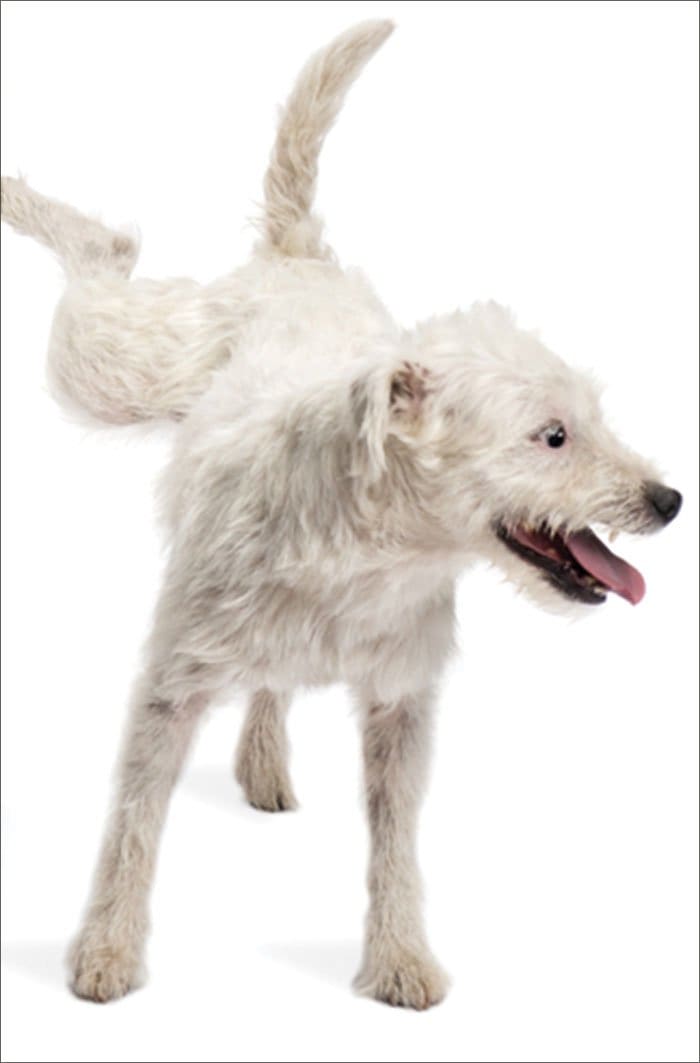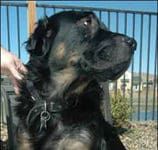[Updated August 6, 2018]
I can still remember the day, more than a decade ago, when I first realized with horror that our Scottish Terrier, Dubhy (pronounced “Duffy”), was marking in the house. We were trying to sell our Tennessee home at the time, which made the indoor leg-lifting behavior doubly disturbing. Homes with urine stains and odors don’t show particularly well. Dubhy was young, just over a year old. I wrote off the amber-colored stains I found on the heater vent to not-quite-finished housetraining, redoubled my management efforts, and stepped up the “potty outside” routine. It didn’t help. I began to question my professional dog-trainer credentials. Personally faced with persistent indoor marking, one of the more frustrating challenges dog owners encounter, I was not succeeding at resolving it.

Leg-lifting is a natural, normal behavior for dogs, especially (although not exclusively) for males. Of course, like lots of other natural, normal dog behaviors, it’s unacceptable to most owners. Fortunately, most male dogs learn pretty quickly that humans, for some unfathomable reason, don’t appreciate their efforts to tell the world that the house, and all items within in it, are the property of the dog and his family. “Keep your paws off!” he is saying to the world.
Indoor marking is also often a function of stress. Dogs who are anxious about their environment are more likely to mark indoors than those who are relaxed and calm. Stress-related marking is harder to modify than the simple “This is my stuff” leg-lifting. Dubhy was a calm, easygoing, laid-back dude. The idea of stress-induced marking didn’t even enter my mind.
Only after several years had passed did I realize that Dubhy’s indoor marking coincided precisely with the start of his dog-reactive behavior. The dog reactivity emerged as the result of a pair of roaming Labradors Retrievers (who lived a mile away) who repeatedly breached their underground shock fence, visited our yard, and fought through our fence with our indomitable Scottie. I eventually realized well after the fact that the two behaviors were connected. Duh. The stress of the two intruding Labradors set off Dubhy’s marking.
Neutering Usually Stops Urine Marking
In Dubhy’s case, my initial analysis of incomplete housetraining, although incorrect, was not entirely off base. Indoor marking often begins in adolescent males because it is a natural behavior. Those “easy” cases often respond well to standard housetraining protocols: increasing the dog’s management to reduce his opportunity to mark, taking him outdoors to potty far more frequently, reinforcing appropriate elimination outside, and interrupting any leg lifts you happen to see with a reminder: “Oops! Outside!”
Of course, housetraining and/or behavior-modification efforts need to be accompanied by a good clean-up program using an enzymatic cleaner, to eliminate any lingering odor of urine (which invites the dog to mark again). It’s also important to rule out or treat any urinary-tract infections as possible contributors to inappropriate elimination. And don’t forget neutering!
According to Dr. Nicholas Dodman, veterinary behaviorist at Cummings School of Veterinary Medicine at Tufts University, about 60 percent of intact male dogs will stop urine-marking within weeks or months if they are neutered. Other sources claim as high as a 90 percent success rate post-neutering.
Suffice it to say that neutering is a good first step if your dog reverts back to peeing in the house. This is at least in part because intact male dogs will mark everything in response to the scent of a female in season somewhere in the area, and in part because testosterone in general contributes to the motivation to make a “this is mine” statement. Marking by female dogs will also usually resolve with spaying. Of course, the older the dog and the longer your dog has been practicing the marking behavior, the less likely it is that sterilization alone will fix the problem.
Dubhy, however, was neutered some five months before he started marking. That clearly wasn’t the answer to our dilemma. Nor did our return to a basic housetraining protocol stop his behavior.
Stress Generally Causes Dogs to Mark the House
The 10 to 40 percent of dogs who don’t stop their marking after neutering and remedial housetraining efforts are probably, like Dubhy, marking because of stress. In some cases, identifying stressors and removing them can eliminate marking. There are a variety of different strategies for removing stressors. The more stress you can remove, the more likely it is the marking will cease. Other than his reactive aggression toward other dogs, however, Dubhy was a pretty laid-back, mellow guy. We had talked to the neighbors on several occasions about keeping their wandering Labrador Retrievers at home, but Dubhy really didn’t seem to have a whole lot of additional stress in his life.
Exercise is an excellent stress reducer that can help your indoor-marker feel less compelled to lift his leg in your living room. Vigorous off-leash aerobic outings can work wonders with a variety of behavioral issues, as can force-free training routines that require a dog to think, and that tire him mentally. Products such as Adaptil (plug-in pheromone diffuser) can also be effective in decreasing stress levels for some dogs, as can calming massage, aromatherapy, and musical products from Through a Dog’s Ear (see “5 Things to Do if Your Dog Needs Cage Rest,” (August 2014).
How to Manage Urine Marking Indoors
Dr. Dodman suggests that dogs who persistently mark indoors and don’t respond to neutering and housetraining protocols almost always need anti-anxiety medication to resolve the problem. Indeed, pharmaceutical intervention can be quite successful, especially when combined with an ongoing behavior modification program.
Many dog owners prefer to avoid medication if possible, and choose, instead, to use a belly band for their indoor male markers (diapers are necessary for females). This is a reasonable solution to a vexing problem, if the dog accepts the device easily. If the dog can routinely Houdini his way out of the band, or is clearly distressed by wearing it, then it’s not a viable option and medication is a better choice.
We opted for management with Dubhy. He happily accepted his belly band, lined with a sanitary pad, and stood quietly when I told him it was time to put his pants on. Delivering a treat after applying the belly band helped keep him happy about the procedure. He would still mark into the band, so I had to change it as needed to prevent urine burns on his sensitive, bare abdomen.
Our earlier housetraining effort had at least succeeded in convincing Dubhy not to mark in our presence, so he could go pants-free when the family relaxed together evenings in the living room, and for sleep-time overnight in our bedroom. We used baby gates and closed doors to keep him in view. It was only for his unsupervised house-time that the band was required. Sure, I occasionally grumbled internally about the inconvenience of replacing pads and laundering belly bands, and groused out loud when he occasionally managed to pee out from under the band and I had to do clean-up duty, but it allowed us to have a peaceful life with our boy who might otherwise have been the source of much angst over the years.
We lost our beloved Dubhy a few months ago to lymphoma – a nasty and aggressive cancer. We miss him a lot. I’d give anything to have the privilege of putting belly bands on him again.
Ways to Approach Your Dog’s Pee-Inducing Stressors
I utilize five strategies for dealing with stressors. When I’m working with a client whose dog has stress-related behavior issues such as marking, aggression, or generalized anxiety, we list as many stressors as we can think of, assign one or more strategies to each stressor, and agree on which ones we will actively work on. Removing stressors doesn’t necessarily make the unwanted behavior go away, but it does make your behavior-modification efforts much more likely to be successful.
Here are the strategies:
1. Get rid of it
Get rid of anything aversive that causes unnecessary pain or stress, including shock collars, choke chains, and prong collars, and penny cans or throw chains. Even head halters, considered by some trainers to be positive training tools, are aversive to many dogs.
2. Manage your dog’s exposure to the stressors
If your dog isn’t fond of small children and there are none in your life (and he doesn’t encounter them regularly in your neighborhood), you can manage him (as I did) the one time each year your sister comes to visit with your young niece and nephew, by keeping him in another part of the house when the kids are awake and about.
3. Change his association to the stressors
Convince him that something that stresses him is actually very wonderful by pairing it consistently with something else wonderful. If your dog is stressed by men with beards, you can convince him that men with beards always make chicken happen by having a bearded man appear, and feeding your dog bits of chicken, over and over and over again, until he wants furry-faced men to appear so he can have more chicken. The key to successful counter-conditioning, as this process is called, is to always keep the dog below threshold; you want him a little aware of and worried about the aversive stimulus, but not quaking in fear or barking and lunging. (See “Counter-Conditioning,” below.)
4. Teach him a new behavior around the stressors
Perhaps your dog becomes highly aroused by visitors coming to the door. He’s not fearful or aggressive, but the high arousal is a stressor. You can teach him that the doorbell is his cue to run and get in his crate, where he’ll receive a stuffed Kong or other doggie delectable (see “Unwanted Barking at the Front Door,” February 2010). Or you can teach him that visitors will toss toys for him to chase if he sits politely when the door opens.
5. Live with the stressors
You don’t have to actively do something about every stressor in your dog’s world; every dog can tolerate some level of stress and a few stressors. Just try to do something about the ones that are easy to manage or remove from his environment, and be conscious that when he’s being exposed to the ones that you can’t do much about (say, sounds of construction coming from the building project next door), he may be more likely to exhibit urine-marking or other stress-related behaviors at that time.
Counter-Conditioning Urine Marking
Counter-conditioning involves changing your dog’s association with a scary or arousing stimulus from negative to positive. The easiest way to give most dogs a positive association is with very high-value, really yummy treats. I like to use white meat from chicken – canned, baked, or boiled, since most dogs love chicken and it’s a low-fat food.
Here’s how the process works:
1. Determine the distance at which your dog can be in the presence of the stimulus and be alert or wary but not extremely fearful or aroused. This is called the threshold distance.
2. With you holding your dog on leash, have a helper present the stimulus at threshold distance X. The instant your dog sees the stimulus, start feeding him bits of chicken, non-stop.
3. After several seconds, have the helper remove the stimulus, and stop feeding chicken.
4. Keep repeating steps 1-3 until the presentation of the stimulus at that distance consistently causes your dog to look at you with a happy smile and a “Yay! Where’s my chicken?” expression. This is a conditioned emotional response (CER) – your dog’s association with the stimulus at threshold distance X is now positive instead of negative.
5. Now you need to increase the intensity of the stimulus. You can do that by decreasing distance to X minus Y; by increasing movement of the stimulus at distance X (a child walking, skipping, or swinging her arms); by increasing number of stimuli (two or three children, instead of one); increasing the visual “threat” (a tall man instead of a short one, or a man with a beard instead of a clean-shaven one); or by increasing volume (if it’s a stimulus that makes noise, such as a vacuum cleaner). I’d suggest decreasing distance first in small increments by moving the dog closer to the location where the stimulus will appear, achieving his new CER at each new distance, until he is happy to be very near to the non-moving stimulus, perhaps even sniffing or targeting to it.
6. Return to distance X and increase the intensity of your stimulus (move the vacuum a little; have two children instead of one; have the man put on a hat, or a backpack), gradually decreasing distance and attaining CERs along the way, until your dog is delighted to have the moderately intense stimulus in close proximity.
7. Now, back to distance X, increase intensity again, by having your helper turn the vacuum on briefly, feed treats the instant it’s on, then turn it off, and stop the treats. (Or turn up the volume, or add more children, etc.)
8. Repeat until you have the CER, then gradually increase the length of time you have your dog in the presence of the increased-intensity stimulus, until he’s happy (but not aroused) to have it present continuously.
9. Begin decreasing distance in small increments, moving the dog closer to the stimulus, obtaining his new CER consistently at each new distance.
10. When your dog is happy to have the higher-intensity stimulus close to him, you’re ready for the final phase. Return to distance X and obtain his new CER there, with a full-intensity stimulus – a running, moving vacuum; multiple children laughing and playing; a tall man with a beard wearing a hat, sunglasses, and a backpack. Then gradually decrease distance until your dog is happy to be in the presence of your full-intensity stimulus. He now thinks the stimulus is a very good thing, as a reliable predictor of very yummy treats. In the case of a human stimulus, you can gradually work up to actual interaction with the human(s) at this stage, by having the person(s) drop treats as they walk by, then letting him take treats from their fingers – without direct eye contact, and eventually working up to normal interaction.
Pat Miller, CBCC-KA, CPDT-KA, is WDJ’s Training Editor. She lives in Fairplay, Maryland, site of her Peaceable Paws training center, where she offers dog-training classes and courses for trainers.






I woud love to tell you about my Cocker Spanie Pickle. He is eleven years old and neutered. He has marked regularly indoors for years. This is triggered by one thing only – sniffing the bum of one of my female dogs. Pavlovian. It happens more at the start of the day, never in the evening when in other repsects his stress levels will have peaked. He’s an excitable working Cocker.
I simply neutralise the smell and clean it up. Fortunatly my floor is wooden apart form rugs in the middle and sofas leather. Nothing absorbant.
As a behaviourist I’ve not come across this in any of my clients’ dogs.